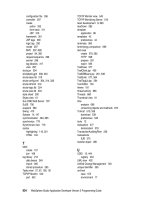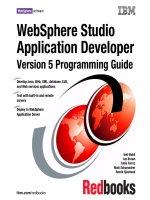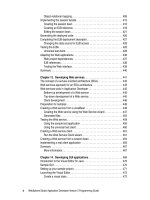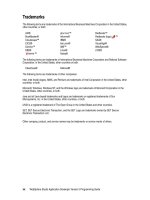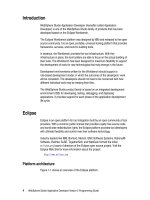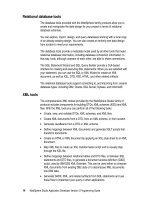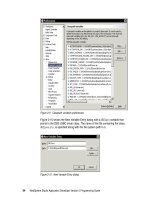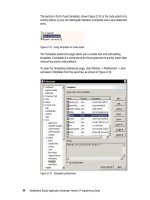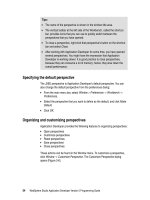WebSphere Studio Application Developer Version 5 Programming Guide part 45 doc
Bạn đang xem bản rút gọn của tài liệu. Xem và tải ngay bản đầy đủ của tài liệu tại đây (256.38 KB, 10 trang )
414 WebSphere Studio Application Developer Version 5 Programming Guide
Figure 12-37 Object-relational mapping editor
The Outline view of the mapping editor summarizes our mapping activities
(Figure 12-38).
Chapter 12. Developing EJB applications 415
Figure 12-38 Outline view of the mapping editor
Save the mapping (Ctrl-s) and close the editor.
Implementing the session facade
The last EJB that we have to build is the facade: the BankEJB stateless session
bean (Figure 12-39).
Figure 12-39 Business model facade
m:m
1:m
TransRecord
Customer
Account
Facade
Business Model
BankEJB
416 WebSphere Studio Application Developer Version 5 Programming Guide
Creating the session bean
In the J2EE Hierarchy view, select
New -> Enterprise Bean
from the
ItsoProGuideEJB context menu. Check the project name and click
Next
to
advance to the wizard’s first page (Figure 12-40).
Figure 12-40 Creating a new session bean (page 1)
Select the
Session bean
option and type BankEJB in the Bean name field. Type
itso.ejb.model.facade in the
Default package
field and click
Next
to continue
(Figure 12-41):
Make sure that you have the correct selections
Stateless
and
Container
.
Note that this time around, Application Developer suggests that you create a
remote client view instead of a local client view. This is because the
environment knows that session beans are normally used to implement the
model’s facade and, as such, need remote interfaces as opposed to local
ones.
The next wizard’s page is just like the one shown in Figure 12-14 on page 394
and need not be altered as well.
You may as well click
Finish
to complete the creation of your session bean.
Chapter 12. Developing EJB applications 417
Figure 12-41 Creating a new session bean (page 2)
If you open the
J2EE Hierarchy
view, you will be able to see the newly created
session bean (Figure 12-42).
Figure 12-42 J2EE Hierarchy view of session bean
418 WebSphere Studio Application Developer Version 5 Programming Guide
Note that for session beans, just three types are generated by the wizard: the
remote home interface, the remote component interface, and the bean class.
There is no need to have a key class because session beans are not persistent.
Creating an EJB reference
An EJB reference is a logical (alternative) name used to locate the home
interface of an enterprise bean used by an application. Using a logical name
instead of the complete JNDI name allows applications to use hard coded strings
to reference other beans and still be easy to maintain.
The link between the logical name and the real bean is defined in the EJB
deployment descriptor and does not involve changing the code. At deployment,
the EJB reference is bound to the enterprise bean's home in the target
operational environment. The container makes the application's EJB references
available in a JNDI naming context.
In Application Developer, EJB references are edited using the EJB deployment
descriptor editor (Figure 12-43).
Figure 12-43 EJB references
As you can see, some references have already been defined for you. Application
Developer automatically does that when you create relationships among entity
beans. We now have to add references to the BankEJB facade, so that it can
access the entity beans without having to use the complete JNDI name.
logical name
Chapter 12. Developing EJB applications 419
Select the BankEJB bean and click
Add
. A dialog that lets you select the kind of
reference to add is displayed (Figure 12-44).
Figure 12-44 Reference types
EJBs may reference other EJBs either through a remote or local interface. They
may also reference resources and security roles. Since our entity beans are all
local to the session bean, select
EJB local reference
and click
Next
to continue.
The next dialog (Figure 12-46) lets you specify the information of the referenced
local EJB:
You do not have to fill in all the fields, because Application Developer knows
all the information if only you let it know which EJB you would like to
reference.
Locate the Link field, but instead of typing the information, click
Browse
to
open the Link Selection dialog.
Select the Customer bean from the drop-down combo box and click
OK
.
Click
Finish
to create the reference.
420 WebSphere Studio Application Developer Version 5 Programming Guide
Figure 12-45 Adding an EJB local reference
Repeat the same process for the Account and the TransRecord bean. When you
are done, the References page of the EJB deployment descriptor should look like
Figure 12-46.
Figure 12-46 BankEJB bean references
Save your changes and close the editor.
Chapter 12. Developing EJB applications 421
Editing the session bean
To be compatible with our existing control and presentation layers, the improved
model layer must expose the very same set of operations that were made public
by the previous JavaBean implementation. These operations are as follows:
public BigDecimal deposit(String accountID, BigDecimal amount)
throws AccountDoesNotExistException, CreateException
public BigDecimal withdraw(String accountID, BigDecimal amount)
throws InsufficientFundsException, AccountDoesNotExistException,
CreateException
public BigDecimal transfer(String accountID1, String accountID2,
BigDecimal amount) throws InsufficientFundsException,
AccountDoesNotExistException, CreateException
public Customer getCustomer(String customerID) throws
CustomerDoesNotExistException
public Account getAccount(String accountID) throws
AccountDoesNotExistException
public Account[] getAccounts(String customerID) throws
CustomerDoesNotExistException
public TransRecord[] getTransactions(String accountID) throws
AccountDoesNotExistException
Caching the initial context and the EJB homes
Open the BankEJBBean class with a Java editor. To implement the methods listed
above, we will make use of some private helper methods and properties.
Declare the following properties inside the class definition body:
private Context context;
private AccountLocalHome accountHome;
private CustomerLocalHome customerHome;
private TransRecordLocalHome transRecordHome;
They will hold, respectively, cached references to the initial naming context and
the homes of the entity beans.
Errors may be reported because of missing import statements. Correct them by
selecting
Source -> Organize Imports
. When asked to inform the complete name
of the Context type, select javax.naming.Context.
Note: The EJB methods can throw additional exceptions, for example,
CreateException is thrown if the create of a TransRecord fails.
422 WebSphere Studio Application Developer Version 5 Programming Guide
Now make Application Developer generate getter methods for the three
properties. Select
Source -> Generate Getter and Setter
and then select only the
getter methods for all three properties.
Change all three methods from public to private, and then perform changes to
the code as shown in Figure 12-47.
Figure 12-47 BankEJB bean getter methods
All three properties will be lazy-initialized when the getters are called for the first
time. Add the appropriate imports to the javax.naming.InitialContext and
javax.naming.NamingException types.
Now enter the remaining three helper methods (Figure 12-48).
private Context getContext() throws NamingException {
if (context == null) context = new InitialContext();
return context;
}
private AccountLocalHome getAccountHome() {
if (accountHome == null)
accountHome = (AccountLocalHome)lookup("ejb/Account"));
return accountHome;
}
private CustomerLocalHome getCustomerHome() {
if (customerHome == null)
customerHome = (CustomerLocalHome)lookup("ejb/Customer");
return customerHome;
}
private TransRecordLocalHome getTransRecordLocalHome() {
if (transRecordHome == null)
transRecordHome = (TransRecordLocalHome)lookup("ejb/TransRecord");
return transRecordHome;
}
Note: The get methods to retrieve the local homes of the entity beans invoke
the lookup helper method with the name of the EJB reference that we defined
for the session bean, for example, ejb/Account.
Chapter 12. Developing EJB applications 423
Figure 12-48 Beanking bean private helper methods
Adding business methods
To complete the facade, we have to enter its public methods as shown in
Example 12-1.
Example 12-1 Business methods of BankEJB session bean
public BigDecimal deposit(String accountID, BigDecimal amount)
throws AccountDoesNotExistException, CreateException {
AccountLocal account = getAccountLocal(accountID);
account.deposit(amount);
getTransRecordHome().create("C", amount, account);
return account.getBalance();
}
public BigDecimal withdraw(String accountID, BigDecimal amount)
throws InsufficientFundsException, AccountDoesNotExistException,
CreateException {
AccountLocal account = getAccountLocal(accountID);
private Object lookup(String referenceName) {
try { return getContext().lookup("java:comp/env/" + referenceName);
} catch (NamingException e) { throw new EJBException(e); }
}
private CustomerLocal getCustomerLocal(String customerID)
throws CustomerDoesNotExistException {
try { return getCustomerHome().findByPrimaryKey
(new CustomerKey(Integer.valueOf(customerID).intValue()));
} catch (FinderException e) { throw new CustomerDoesNotExistException();
}
}
private AccountLocal getAccountLocal(String accountID)
throws AccountDoesNotExistException {
try { return getAccountHome().findByPrimaryKey(accountID);
} catch (FinderException e) { throw new AccountDoesNotExistException();
}
}
Notes:
The lookup method uses the context with the java:comp/env/ejbreference
argument to retrieve a home object.
We do not require a getTransRecordLocal method. Transaction records are
only created (using the home) or retrieved from an account through the
relationship.
